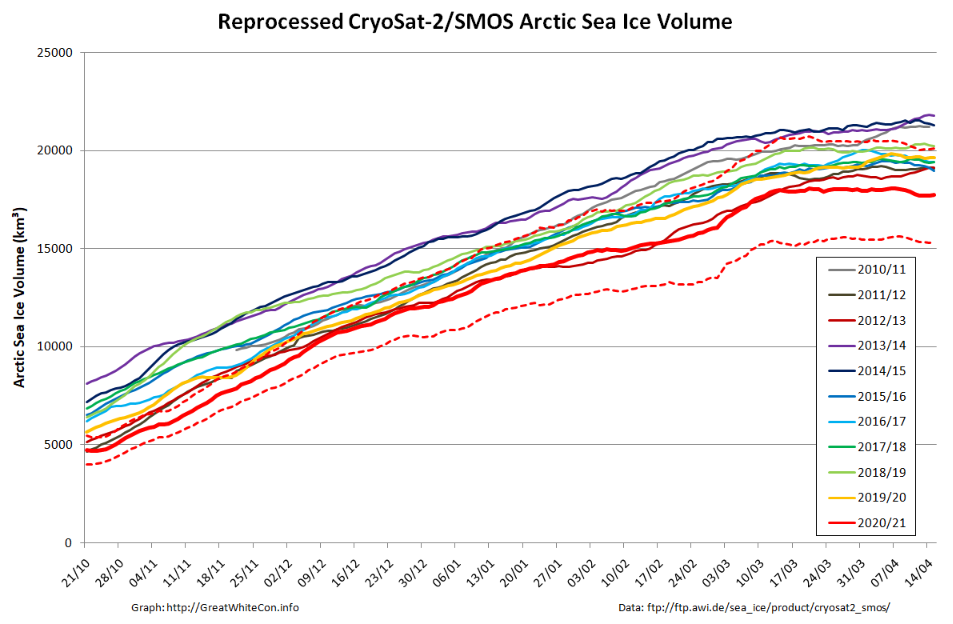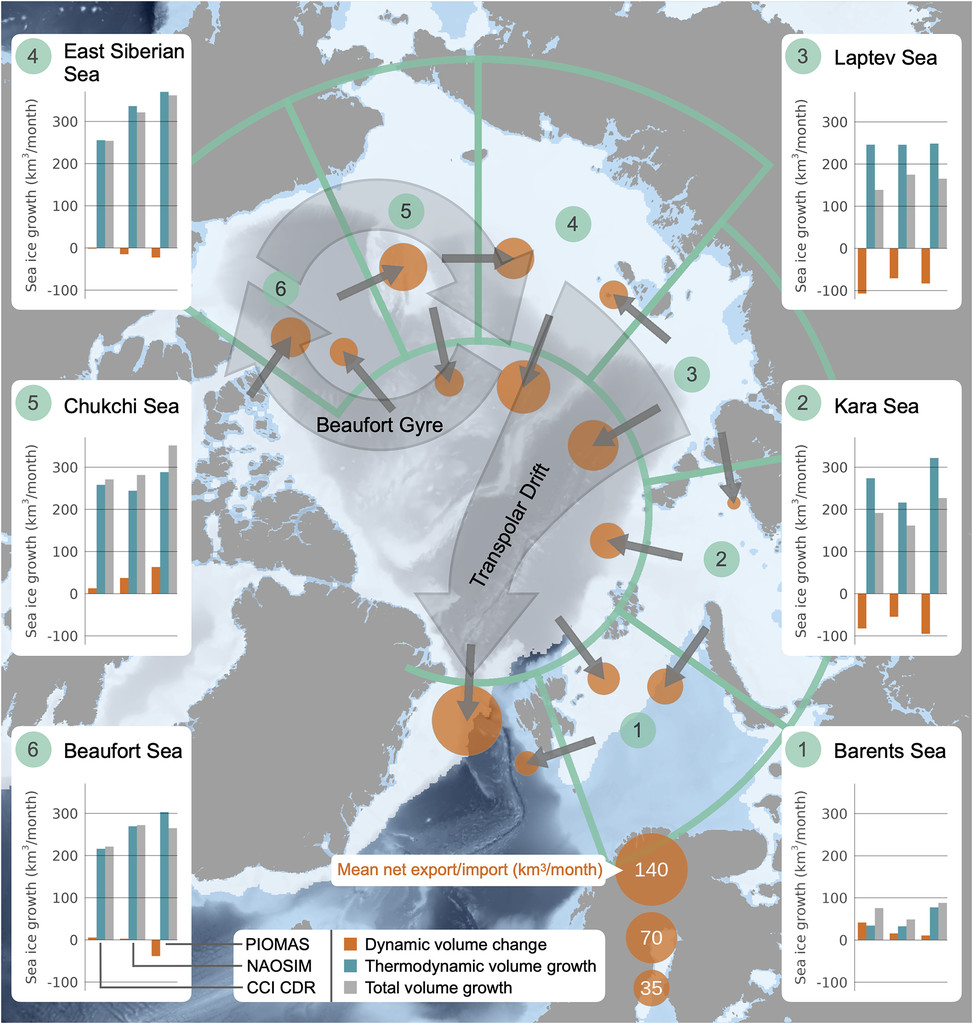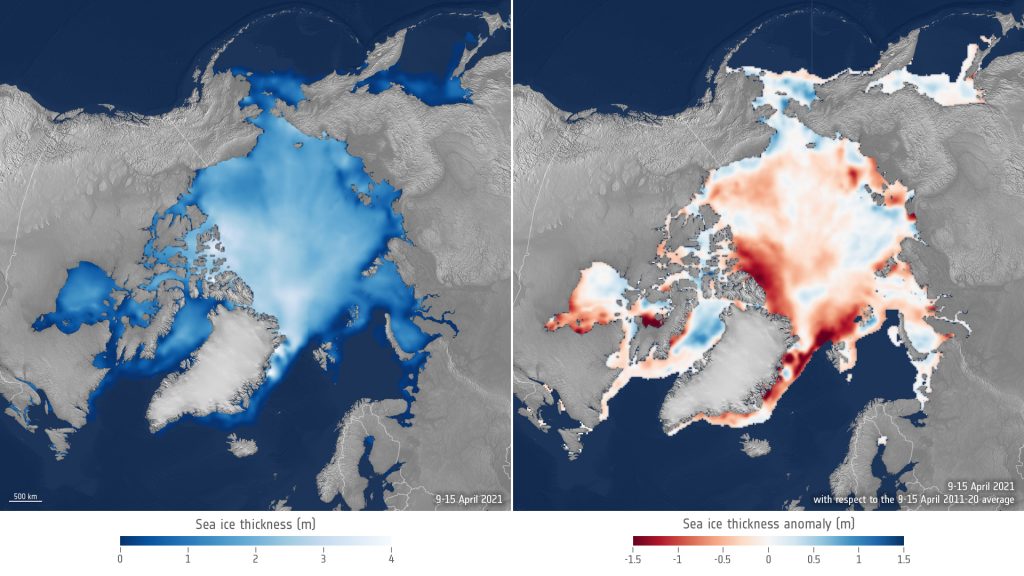Inspired by my recent visits to Judith Curry’s blog this post will bring you links to the latest learned journal articles about Arctic sea ice. Together with occasional excursions into older and wider Arctic papers.
Judith’s “Week in Review” articles seem to last for a month, so this one will probably last for at least a year!
First up is an article apparently written by a regular reader of this humble web site! A University of Alaska article at phys.org begins:
In August 2016 a massive storm on par with a Category 2 hurricane churned in the Arctic Ocean. The cyclone led to the third-lowest sea ice extent ever recorded. But what made the Great Arctic Cyclone of 2016 particularly appealing to scientists was the proximity of the Korean icebreaker Araon.
For the first time ever, scientists were able to see exactly what happens to the ocean and sea ice when a cyclone hits. University of Alaska Fairbanks researchers and their international colleagues recently published a new study showing that sea ice declined 5.7 times faster than normal during the storm. They were also able to prove that the rapid decline was driven by cyclone-triggered processes within the ocean.
Note that it didn’t take us 5 years to write about the cyclone in question. Our article catchily entitled “The Great Arctic Cyclone of 2016” was published on August 13th 2016:
A storm is brewing in the Arctic. A big one! The crew of the yacht Northabout are currently sailing along the western shore of the Laptev Sea and reported earlier today that “The sea is calm. Tomorrow a gale 8. But this moment is perfect”.
That perfect moment will not last long.
I interviewed polar explorer David Hempleman-Adams about the succeeding moments once Northabout had returned to the UK. It seems riding out the cyclone was the most frightening experience he had ever had.
The University of Alaska article references the following peer reviewed paper:
“Role of Intense Arctic Storm in Accelerating Summer Sea Ice Melt: An In Situ Observational Study“
The next on my list of must read papers comes complete with a video:
I don’t know who came up with the “Heat Bomb” misnomer, since it isn’t mentioned in the paper itself:
“A warm jet in a cold ocean” by Jennifer MacKinnon et al. from the Scripps Institution of Oceanography.
Unprecedented quantities of heat are entering the Pacific sector of the Arctic Ocean through Bering Strait, particularly during summer months. Though some heat is lost to the atmosphere during autumn cooling, a significant fraction of the incoming warm, salty water subducts (dives beneath) below a cooler fresher layer of near-surface water, subsequently extending hundreds of kilometers into the Beaufort Gyre. Upward turbulent mixing of these sub-surface pockets of heat is likely accelerating sea ice melt in the region.
Last but certainly not least for today is a slightly older review paper:
Understanding Arctic Ocean Circulation: A Review of Ocean Dynamics in a Changing Climate” by Mary‐Louise Timmermans from Yale and John Marshall of MIT.
[Edit – May 21st]The Arctic Ocean is a focal point of climate change, with ocean warming, freshening, sea‐ice decline, and circulation that link to the changing atmospheric and terrestrial environment. Major features of the Arctic and the interconnected nature of its wind‐ and buoyancy‐driven circulation are reviewed here by presenting a synthesis of observational data interpreted from the perspective of geophysical fluid dynamics (GFD). The general circulation is seen to be the superposition of Atlantic Water flowing into and around the Arctic basin and the two main wind‐driven circulation features of the interior stratified Arctic Ocean: the Transpolar Drift Stream and the Beaufort Gyre. The specific drivers of these systems, including wind forcing, ice‐ocean interactions, and surface buoyancy fluxes, and their associated GFD are explored. The essential understanding guides an assessment of how Arctic Ocean structure and dynamics might fundamentally change as the Arctic warms, sea‐ice cover declines, and the ice that remains becomes more mobile.
A new paper has been published on one of our favourite topics, Arctic sea ice volume. It’s accompanied by a press release from the European Space Agency, and this video:
According to the ESA press release:
Arctic sea ice reaches a maximum around March after the cold winter months and then shrinks to a minimum around September after the summer melt. However, these seasonal swings are not only linked to the changing seasons – it transpires that along with our warming climate, the temperature of adjacent ocean seawater is now also adding to the ice’s vulnerability.
Previous research suggested that sea ice can partly recover in the winter following a strong summer melt because thin ice grows faster than thick ice. However, new findings indicate that heat from the ocean is overpowering this stabilising effect – reducing the volume of sea ice that can regrow in the winter. This means that sea ice is more vulnerable during warmer summers and winter storms.
The research published recently in the Journal of Climate describes how scientists used satellite data from ESA’s Climate Change Initiative to calculate changes in the volume of Arctic sea ice between 2002 and 2019.
Here’s our more up to date version of the CryoSat-2/SMOS volume graph included in the press release:

The paper itself is entitled “Evidence for an Increasing Role of Ocean Heat in Arctic Winter Sea Ice Growth“, and the abstract reads as follows:
We investigate how sea ice decline in summer and warmer ocean and surface temperatures in winter affect sea ice growth in the Arctic. Sea ice volume changes are estimated from satellite observations during winter from 2002 to 2019 and are partitioned into thermodynamic growth and dynamic volume change. Both components are compared with validated sea ice–ocean models forced by reanalysis data to extend observations back to 1980 and to understand the mechanisms that cause the observed trends and variability. We find that a negative feedback driven by the increasing sea ice retreat in summer yields increasing thermodynamic ice growth during winter in the Arctic marginal seas eastward from the Laptev Sea to the Beaufort Sea. However, in the Barents and Kara Seas, this feedback seems to be overpowered by the impact of increasing oceanic heat flux and air temperatures, resulting in negative trends in thermodynamic ice growth of −2 km3 month−1 yr−1 on average over 2002–19 as derived from satellite observations.
Here’s an infographic from the paper that illustrates the conclusions:

Going back to the press release:
Robert Ricker, from the AWI Helmholtz Centre for Polar and Marine Research in Germany… said “Over the last decades we observed the tendency that the less ice you have at the beginning of the freezing season, the more it grows in the winter season.
“However, what we’ve found now is that in the Barents Sea and Kara Sea regions, this stabilising effect is being overpowered by ocean heat and warmer temperatures that are reducing the ice growth in winter.”
This new process is called Atlantification, meaning that heat from the Atlantic Ocean carried to higher latitudes is causing the edge of the sea ice to retreat.
“Importantly, this also means that if you have a warm summer or strong winds, the sea ice is less resilient,” added Dr Ricker.
The Alfred Wegner Institute (AWI) in Germany merge weekly CryoSat data with daily SMOS data to generate a weekly-averaged product every day.
As well as being used for forecasts, these combined data show that the volume of sea ice in the 2020-21 winter season was at its lowest since these sea-ice data products began in 2010.
Stefan Hendricks from AWI said, “The driver of this low volume of sea ice is the region north of Greenland and the Canadian Archipelago, where the thickest ice usually resides. Last winter, thick sea ice was almost absent. The rest of the Arctic sea ice is a mix of above and below average.”
Here once again is the mid April 2021 Arctic sea ice thickness map from the AWI, albeit using a different colour scheme, plus a thickness anomaly map:

This makes it abundantly clear that the “oldest, thickest sea ice in the Arctic” that used to be located north of Greenland and the Canadian Arctic Archipelago is no longer there.
More Arctic science news, including the new CPOM CryoSat-2 paper from Robbie Mallet, can be seen on the new June thread:
https://GreatWhiteCon.info/2021/06/month-in-review-arctic-science-edition-2/
A new paper has just been published to “Test the hypothesis that the stabilizing feedback of winter ice growth is reduced by the rising impact of warmer ocean and surface temperatures in the European sector of the marginal seas, including the Barents and Kara Seas”. See above:
https://GreatWhiteCon.info/2021/05/month-in-review-arctic-science-edition/#Ricker
See also the following background information on the demise of “oldest, thickest sea ice in the Arctic”:
Rotation into the Beaufort Sea in the spring of 2016:
https://GreatWhiteCon.info/2016/04/the-beaufort-gyre-goes-into-overdrive/
“Garlic pressed” old ice pursuing Northabout through the CAA later that year:
https://GreatWhiteCon.info/2016/08/northabout-braves-the-northwest-passage/#Sep-11
Widespread “lift off” from North Greenland in summer 2018:
https://GreatWhiteCon.info/2018/08/could-northabout-circumnavigate-greenland-in-2018/
Rotation into the Beaufort Sea and export into the “far North Atlantic” during the subsequent winter:
Continuous export via the Nares Strait during the same winter:
https://GreatWhiteCon.info/2019/03/facts-about-the-arctic-in-march-2019/#Mar-22
Q.E.D?